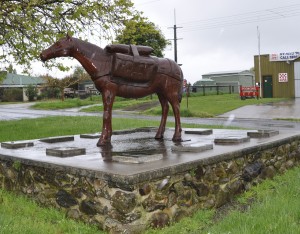In the main street of the town of Poowong, there is a statue commemorating the packhorse.
Curiously, the statue – for some of us at least – tricks the unwary mind towards the assumption that this is the obligatory memorial for the fallen of the Great War. Perhaps this is because it is situated where we might expect in most towns to find a cenotaph (there is one in Poowong, at the other end of the main street, from memory), but it is also because the image resonates with some of the hard-wired imagery of the Great War. Simpson and his donkey is the obvious resonance, but there are many other images of the horse struggling through mud, often trying to tow small artillery. The image has a real symbolic power.
There is a strong resonance of the Great War in the book, though perhaps this is a inferred subtext that may not be as present in the text as I might think. In any case, the process creating the text weaves in and out of the war. It was meant to be published in around 1914-15, but was delayed till the early 20s. And there is also a realisation – again not stated in the text – that may of the men who fought and died would have been the sons of these settlers.
The strongest resonances though are in the structure and style of the narrative, the suffering and grandeur of the agon and the positioning of the individual in the blasted landscape. It’s hard not to think that the triumphal nature of the Lyrebird narrative might have offered some repair to the war-damaged local community.
A key trope shared by both sets of landscape (South Gippsland/the Western Front) is the inescapable mud…


